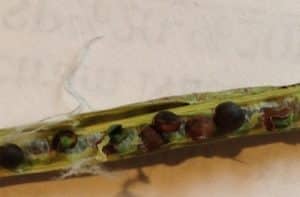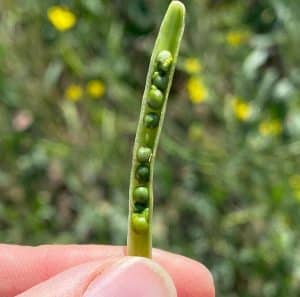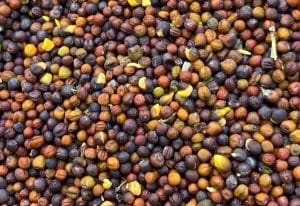Canola seeds sprouting in pods is called “precocious germination”. It can occur in these circumstances:
- Heat stress. A plant hormone response to hot and dry weather can lead to sprouting in pods. More on that below.
- Re-wetting of pods. While canola seeds are much less likely than cereal seeds to sprout before harvest, it can happen if seed moisture drops down to around 10 per cent, then goes back up again with harvest precipitation. Continuous wet weather at harvest can lead to canola seed sprouting.
- Aster yellows. This pathogen can cause all sorts of plant deformities, including sprouted (or otherwise odd-growing) seeds inside the pod. In many cases, these misshapen or malformed seeds will dry up and blow out of the combine. Canola Encyclopedia section on aster yellows.


Heat as a trigger
Hot temperatures at flowering can disrupt reproduction, leading to missing pods or empty pods. Heat can also cause hormone responses that trigger sprouting.
As canola seed embryos develop, high concentrations of a hormone called abscisic acid (ABA) normally inhibit precocious seed germination. (ABA is an important phytohormone for stress tolerance and seed dormancy in plants.) ABA levels gradually decrease during seed filling and maturation stages, inhibiting precocious germination up until the seeds reach their low-moisture dormant state. This is normally a perfectly-timed process. However, heat stress can decrease ABA content. Because of low ABA content, seed dormancy is reduced, making seed more prone to germination within the pod.
A sulphur connection. One study found that heat stress in combination with sulphur limitation was also found to increase the occurrence of precocious germination. (Brunel-Muguet et al., 2015)
Harvest management
If precocious germination has started in a few pods, should the farmer swath the crop now – versus leave it for later swathing or straight combining – to limit the loss?
Making a canola cutting decision based on a few plants with precocious germination is probably not a good idea. In that situation, base decisions around the recommendation to swath at (or after) 60 per cent seed colour change on the main stem. If you find precocious germination in pods throughout a field, that might change the situation. Sprouted seed is graded as “damaged seed” and No.1 canola has a five per cent tolerance for total damage. But what to do? We don’t have enough information around management of precocious germination to answer this question with any strong recommendations. If conditions are looking to stay dry, swathing these crops with precocious germination a little earlier – say at 30 per cent seed colour change – might help a little bit to prevent further precocious germination.
The desiccant diquat possibly could stop precocious germination that would happen very late, but it won’t help any germination that has already occurred. Diquat (Reglone and other brands) stops all further maturity, which is why application timing is 90 per cent brown seeds. Any earlier and it locks in green. More on diquat and other pre-harvest products.

Grading
Sprouted canola is a quality factor and is assessed as Total Damage. The Canadian Grain Commission defines sprouted canola as those seeds with a ruptured seed coat in combination with either a sprout that extends beyond the normal contour of the seed (seeds 1 and 2 below) or distinct swelling (seeds 3 and 4). Seeds like 5 and 6 should only be considered sprouted when found in combination with seeds meeting the definition of sprouted. This is from the Canadian Canola Growers Association’s Know Your Grade website.
No.1 canola can have a maximum five per cent damaged seed. No.2 can have up to 12 per cent damaged seed. No.3 can have up to 25 per cent damaged.
Processors say that sprouted seeds can affect grade if severe enough. It lowers oil content and messes with fatty acids.
